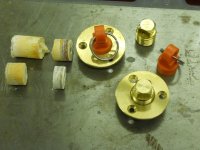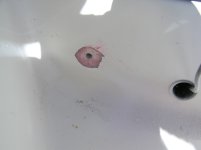joechiro30
New member
- Joined
- Sep 24, 2014
- Messages
- 147
- Reaction score
- 0
- C Dory Year
- 2006
- C Dory Model
- 255 Tomcat
We readjusted the old transducer location and when we did that. We did not properly seal the holes so water leaked in from the hole.
We got the boat out as fast as we could and trailered home. A few days later we wanted to relocate the transducer but this time use starboard so that we don't have to drill more holes in the hull in the future if we wanted to change the location of the transducer to optimize the sonar readings.
As we drilled a new hole through the fiber glass. Water came seaping out. Probably from the previous hole that we made readjusting the transducer. I am waiting for the core to dry now before packing in the epoxy.
We predrilled the holes on the starboard hull to install the starboard in which the transducer will be mounted on. We drilled the holes all the way through to the inside of the fiber glass which I told my guy who was doing the job not to do. I see that he drilled the hole all the way through. He filled and packed the predrilled hole with epoxy and sanded it down and it looks great from the outside of the hull. My question or concern is that since there is a hole through the fiber glass on the inside, did the packing of the epoxy from the outside fill in the hole enough so that water will not get in from the inside where the bilge pump sits on the bottom of the inside hull. When it rains or when we wash down our boat water can some times get down there and my concern is that water may seep into the core from the inside. Do we need to coat or fill with epoxy from the inside as well. It seems like it is hard to get in from the inside down to the bottom of the hull where we drilled the hole.
I don't want water to intrude into the core from the inside. There is a bilge pump there for a reason. Water can get in there where the holes were drilled.
The holes that we found dry we began to fill and pack with epoxy and let it dry.
There are remaining two holes that I am waiting to dry, the other drilled holes have been filled and packed with epoxy.
Is there a way to dry the core besides letting it sit on dry land? I believe the core is not a balsa core like the 22 cruiser but it is a foam core. Is it ok for it to be damp before installing the epoxy?
Any advice would be appreciated before we continue with the install
Thank you
We got the boat out as fast as we could and trailered home. A few days later we wanted to relocate the transducer but this time use starboard so that we don't have to drill more holes in the hull in the future if we wanted to change the location of the transducer to optimize the sonar readings.
As we drilled a new hole through the fiber glass. Water came seaping out. Probably from the previous hole that we made readjusting the transducer. I am waiting for the core to dry now before packing in the epoxy.
We predrilled the holes on the starboard hull to install the starboard in which the transducer will be mounted on. We drilled the holes all the way through to the inside of the fiber glass which I told my guy who was doing the job not to do. I see that he drilled the hole all the way through. He filled and packed the predrilled hole with epoxy and sanded it down and it looks great from the outside of the hull. My question or concern is that since there is a hole through the fiber glass on the inside, did the packing of the epoxy from the outside fill in the hole enough so that water will not get in from the inside where the bilge pump sits on the bottom of the inside hull. When it rains or when we wash down our boat water can some times get down there and my concern is that water may seep into the core from the inside. Do we need to coat or fill with epoxy from the inside as well. It seems like it is hard to get in from the inside down to the bottom of the hull where we drilled the hole.
I don't want water to intrude into the core from the inside. There is a bilge pump there for a reason. Water can get in there where the holes were drilled.
The holes that we found dry we began to fill and pack with epoxy and let it dry.
There are remaining two holes that I am waiting to dry, the other drilled holes have been filled and packed with epoxy.
Is there a way to dry the core besides letting it sit on dry land? I believe the core is not a balsa core like the 22 cruiser but it is a foam core. Is it ok for it to be damp before installing the epoxy?
Any advice would be appreciated before we continue with the install
Thank you





